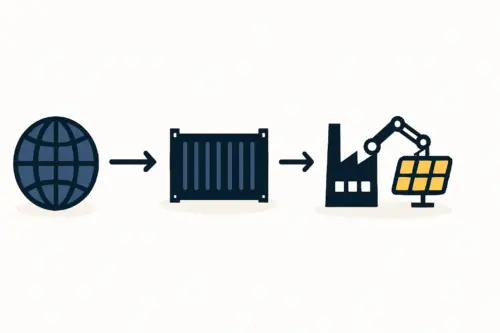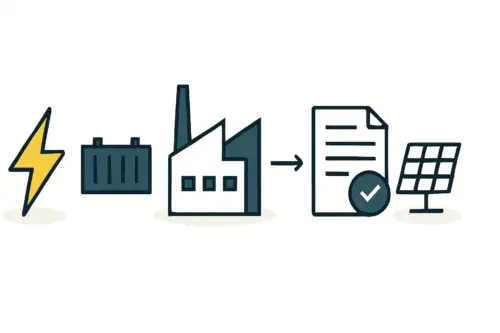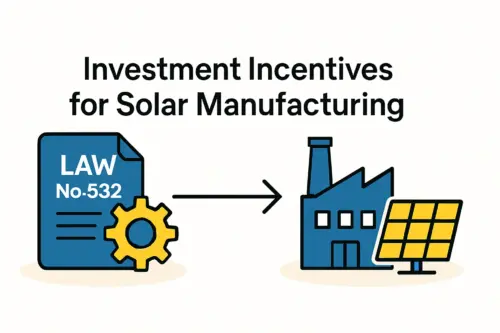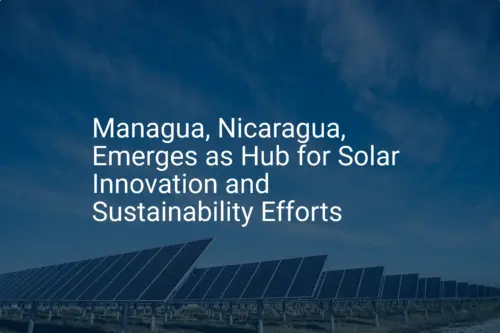Nicaragua’s commitment to renewable energy, combined with its young, growing workforce and competitive labor costs, creates a significant opportunity for entrepreneurs looking to enter solar module manufacturing.
However, investors are often concerned about the perceived gap between the available labor pool and the specialized skills required for high-tech assembly. Success doesn’t depend on finding pre-trained solar experts, but on establishing a systematic process to develop local talent from the ground up.
This guide outlines a strategic framework for recruiting, training, and retaining a skilled technical team for a solar module assembly facility in Nicaragua. It addresses the specific conditions of the local labor market and provides a clear pathway for transforming motivated individuals into a high-performing manufacturing workforce.
Understanding the Nicaraguan Labor Landscape
An effective workforce strategy must begin with a clear understanding of the local context. For investors in Nicaragua, several key factors shape the recruitment and training approach:
-
A Large, Youthful Labor Pool: With a significant portion of its population under 30, Nicaragua offers a large pool of potential employees who are adaptable and eager to learn new technical skills.
-
Foundation in Technical Education: The national vocational training institute, INATEC (Instituto Nacional Tecnológico), provides a baseline of technical education across the country. While its graduates may not have specific solar manufacturing experience, they often possess foundational knowledge in mechanics, electronics, or industrial processes, making them excellent candidates for specialized training.
-
The Skills Gap as an Opportunity: The primary challenge is not a lack of willing workers but a scarcity of experience in precision manufacturing. This gap creates an opportunity for a company to become an employer of choice by investing in high-quality training, building loyalty, and setting a new standard for technical proficiency in the region.
Key Roles in a Solar Module Assembly Line
A typical semi-automated solar module assembly line with an annual capacity of 20–50 MW requires a dedicated team of approximately 25 to 35 employees per shift. Designing a recruitment plan starts with understanding the specific roles required.
Core Production and Technical Roles:
Line Operators: These individuals form the backbone of the production team. They operate specific machines, such as the stringer, layup station, and laminator. The role demands attention to detail, manual dexterity, and the ability to follow standardized procedures precisely.
Quality Control (QC) Inspectors: Positioned at critical points along the line, QC inspectors ensure each component and process meets strict quality standards. They perform visual inspections, operate testing equipment like EL testers and sun simulators, and are responsible for identifying and documenting defects.
Ready to make big Profits?
The solar Industry is Booming
WE HELP NEWCOMERS to the solar industry start their own solar module production line. Customers can make BIG PROFITS by selling modules and finding investors, without wasting money and time on things they don't need!
Maintenance Technicians: Essential for minimizing downtime, maintenance technicians handle preventive maintenance, troubleshooting, and repair of all machinery on the line. A background in mechanical or electrical engineering is highly beneficial for this role.
Production Supervisor: The supervisor oversees the entire production shift, managing the team, monitoring output, enforcing safety protocols, and coordinating with the quality and maintenance departments. This role requires leadership skills and a comprehensive understanding of the entire manufacturing process.
A Strategic Framework for Recruitment and Training
Building a capable team requires a deliberate, multi-stage approach that moves from broad recruitment to highly specialized skill development.
1. Targeted Recruitment Strategies
Instead of searching for non-existent solar experts, the focus should be on identifying candidates with transferable skills and high potential.
-
Collaborate with Technical Institutes: Partnering with INATEC and other vocational schools offers direct access to a pipeline of candidates with relevant foundational knowledge. These institutions can often help pre-screen individuals based on aptitude and work ethic.
-
Look to Adjacent Industries: Seek candidates with experience in industries that require precision and process discipline, such as electronics assembly, medical device manufacturing, or even high-quality textile production. These individuals already understand the importance of quality control and standardized work.
-
Assess for Aptitude over Experience: During the interview process, prioritize assessments that test for manual dexterity, attention to detail, problem-solving ability, and a willingness to learn. These attributes are often more valuable than prior experience, as specific job skills can be taught.
2. A Structured, Phased Training Program
A well-designed training program is the most critical investment in workforce development. Based on experience from J.v.G. turnkey projects, an effective program is built on several distinct phases. This systematic approach is a core part of the complete process of setting up a solar panel factory.
-
Phase I: Classroom Instruction: This initial phase covers the theoretical foundations of solar technology, manufacturing processes, quality standards (e.g., ISO 9001), and workplace safety protocols.
-
Phase II: Hands-On Simulation: Before working on the actual production line, trainees practice on dummy materials and decommissioned modules. This allows them to develop muscle memory and familiarity with the tools and equipment in a low-risk environment.
-
Phase III: Supervised On-the-Job Training: Trainees begin working on the live production line under the close supervision of an experienced trainer. The focus is on reinforcing standardized procedures, achieving target cycle times, and developing an eye for quality.
3. The ‘Train-the-Trainer’ Model
For long-term sustainability and cost-effectiveness, the ‘train-the-trainer’ model is highly recommended. In this approach, a small group of high-potential local hires (future supervisors and lead technicians) receives intensive, in-depth training from an external expert. This often comes as part of the package with turnkey solar module manufacturing lines.
Once this core team is fully proficient, they become the internal trainers responsible for onboarding and developing all future operators. This model has several advantages:
-
Builds In-House Expertise: It creates a sustainable, internal training capability, reducing reliance on external consultants over time.
-
Ensures Consistency: It guarantees that all employees are trained to the same high standard using standardized methods.
-
Cultivates Leadership: It provides a clear career path for promising employees, motivating them to become masters of their craft.
Frequently Asked Questions (FAQ)
Q1: Do we need to hire experienced solar technicians from abroad?
A: For most roles, it is not necessary or cost-effective. The ‘train-the-trainer’ model, where an external expert trains your local supervisors, is a much more sustainable strategy. This approach builds internal capacity and is better suited to the local context.
Q2: What is the typical duration of a new employee training program?
A: For a line operator, the intensive training period typically lasts two to four weeks, followed by several months of supervised work to achieve full proficiency. For maintenance technicians and quality control specialists, the initial training is longer and more in-depth.
Q3: How do local labor costs impact the overall business plan?
A: Nicaragua’s competitive labor costs can be a significant advantage, lowering the factory’s operational expenditure. However, this advantage should be reinvested into strong training and fair compensation to ensure high retention and quality. These factors are a key part of calculating the typical investment costs for a solar manufacturing line.
Q4: What educational background is ideal for line operators?
A: A diploma from a technical or vocational school (bachillerato técnico) is beneficial but not strictly required. The most important qualifications are a strong work ethic, good manual dexterity, the ability to follow instructions precisely, and a commitment to quality.
Conclusion: Investing in People is Investing in Quality
Establishing a solar module assembly facility in Nicaragua is a viable and promising venture. The key to success lies not in finding a ready-made workforce, but in building a robust system for developing one.
By focusing on targeted recruitment, structured training, and the ‘train-the-trainer’ model, investors can build a world-class local team from the ground up. This strategic investment in human capital is the foundation for producing high-quality solar modules and ensuring the operation’s long-term success.









